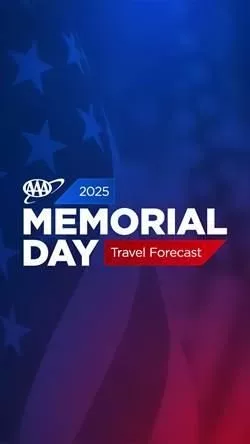
AAA predicts nearly 1.23 million Virginians will be traveling a distance of 50 miles or more this holiday weekend. That’s about 2.5% higher than last year and amounts to about 30,000 more Virginia travelers this year compared to last. Despite the increase in holiday travel volume projections, and outside of the dramatic impacts on travel during COVID-19 in 2020, 2025 is projected to have the lowest year-over-year growth rate in nearly a decade (since 2016) for the Memorial Day holiday. Virginia’s record for the highest number of travelers for the holiday was set back in 2005 (1.24 million).
Total Virginia Travel Growth Rate – Memorial Day Holiday
Year
Growth Rate
2016
+1.7%
2017
+3.1%
2018
+3.6%
2019
+3.0%
2020
-45.2%
2021
+55.6%
2022
+7.7%
2023
+5.8%
2024
+3.6%
2025
+2.5%
“Economic uncertainties are top of mind for travelers right now,” says Morgan Dean, Manager of Public and Government Affairs for AAA Mid-Atlantic in Virginia. “Despite those concerns, Memorial Day weekend marks the unofficial start to summer and for many Virginians that means a long weekend away from work and school at the coast, the bay, the lake, the mountains or at of Virginia’s many tourist attractions.”
By The Numbers
Nearly 9 out of every 10 holiday travelers in the Commonwealth, or 1.08 million, will be hitting the roads for the unofficial start to the summer. Auto travel is predicted to be up 2% over last year and the pre-pandemic numbers of 2019. Some of that increase could be related to lower gas prices. Thanks to lower crude oil prices this summer, late spring gas prices have not seen the usual seasonal spike. With many school systems about to let out and many families looking to get in summer vacations, demand at the pumps is likely to increase and prices will likely climb along with that as we get into the busy summer travel season. Nationally, drivers are paying $3.17 on average for a gallon of regular unleaded. That’s up four cents in the past week, but down 42 cents over this day last year. In Virginia, drivers are paying an average of $2.98 (5/18) which is down 42 cents from this day a year ago. Twenty-four states have gas prices averages under $3/gallon.
More than 104,000 Virginians are set to take to the skies for the holiday, which is a slight increase over the number of air travelers last year at Memorial Day. According to AAA booking data, domestic airline tickets are about 2% more expensive that at this time last year.
In the “other” category, made up of bus, rail and cruise travel, nearly 38,000 Virginians are predicted to travel 50 or more miles. That’s nearly 7% higher than last year, but still far behind the nearly 106,000 who traveled for the holiday back in 2005 when bus and rail travel were very popular in the post 9/11 period. Much of this year’s category growth can be attributed to the popularity of cruising. AAA projects a record 19 million Americans plan to take a cruise in 2025.
2025 Memorial Day Holiday Virginia Travelers
Total Travel
Automobile
Air
Other
(Bus, Train, Cruise)
2025(Forecast)
1.23M
1.08M
104,854
37,775
2024 (Actual)
1.2M
1.06M
103,526
35,412
Change (2024 to 2025)
2.5%
2.5%
1.3%
6.7%
2019 (Actual)
1.19M
1.06M
95,980
30,409
Change (2019 to 2025)
3.3%
2.2%
9.2%
24.2%
National Travel Numbers Recap
Nationally, AAA predicts more than 45.1 million people will travel 50 or more miles for the holiday, which is about 3% higher than the number of holiday travelers we saw in 2024.
· Of those travelers, about 87% are expected to drive to their destinations. That amounts to 39.4 million people hitting the roads.
· 3.6 million passengers nationwide are expected to take to the skies for a getaway, up 1.8% from 2024.
· Just over 2 million are expected to travel by bus, rail or cruise in the “other” category.
Best/Worst Times to Drive
INRIX, a provider of transportation data and insights, expects the afternoons over Memorial Day weekend to be the most congested. Travelers should hit the road during the morning hours. Boston, New York, Los Angeles, San Francisco, and Washington, DC are the metros that can expect the heaviest traffic.